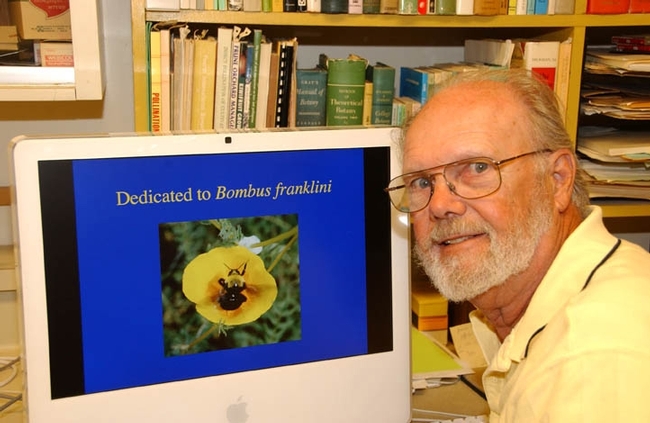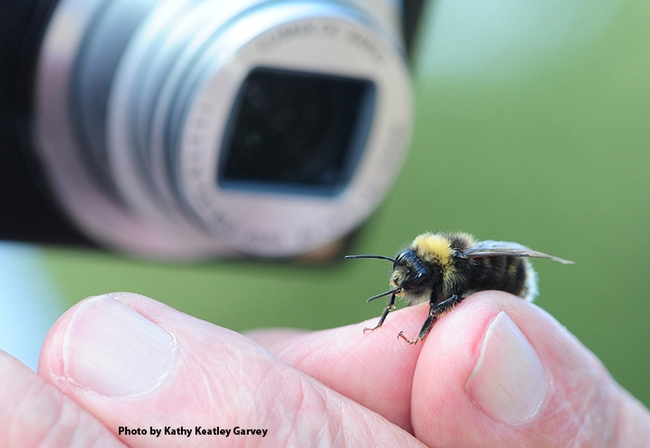- Author: Kathy Keatley Garvey
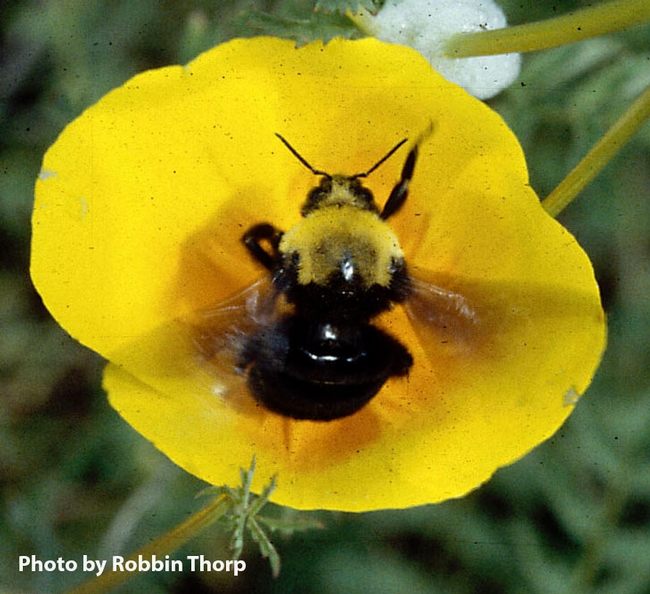
Franklin's bumble bee, Bombus franklini,--a bee that he monitored for decades until his death in 2019--is now protected as an endangered species under the Endangered Species Act (ESA). Protection means opening up funding and resources.
The U.S. Fish and Wildlife Service (FWS) announced its decision Aug. 23 to place the bumble bee, known to inhabit only a small range of southern Oregon and northern California real estate, on the Endangered Species List. Only one other bumble bee, the rusty patched bumble bee, Bombus affinis, is on that list.
Thorp, the last known person to see Franklin's bumble bee in its native habitat, spotted it in 2006 near Mt. Ashland. The bee inhabits--or did--a 13,300-square-mile area confined to five counties--Siskiyou and Trinity counties in California; and Jackson, Douglas and Josephine counties in Oregon. Its range may be the smallest range of any bumble bee species in North America, or even the world, he mused.
Thorp, a member of the UC Davis entomology faculty for 30 years (1964-1994), continued his research, teaching and public service until his death in 2019 at age 85. He was known for his expertise, dedication and passion in protecting native pollinators, especially bumble bees, and for his teaching, research and public service. A worldwide expert on bumble bees, he co-authored the landmark Bumble Bees of North America: an Identification Guide, published in 2014.
The UC Davis scientist especially zeroed in on Franklin's bumble bee. Knowing it was critically imperiled, he and the Xerces Society for Invertebrate Conservation petitioned FWS in 2010 for its endangered species status. In June 2019, just before he died, he was delighted to hear it had made the "proposed list" of endangered species.
Gaining endangered species status could not only lead to its recovery, Thorp told us, but would also help us "better understand environmental threats to pollinators and how to prevent them in future." He called the petition "a wake-up call to the importance of pollinators and the need to provide protections from the various threats to the health of their populations.”
Many Trips to Hunt for the Bee
We recounted his many trips to the five-county area to search for the elusive bumble bee, and his never-fading optimism.
“I am still hopeful that Franklin's bumble bee is still out there somewhere,” Thorp told us in a news article published in 2011. “Over the last 13 years I have watched the populations of this bumble bee decline precipitously. My hope is this species can recover before it is too late."
Thorp's surveys, conducted since 1998, clearly showed the declining population. His Franklin's bumble bee sightings decreased from 94 in 1998 to 20 in 1999 to 9 in 2000 to one in 2001. Sightings increased slightly to 20 in 2002, but dropped to three in 2003. Thorp saw none in 2004 and 2005; one in 2006; and none since.
“Even though none have been seen since 2006, Franklin's bumble bee populations could potentially persist undetected,” FWS wrote in a news release. The bee is listed as endangered, but its habitat is not. Why? “Because the bee is considered to be flexible with regards to its habitat, the availability of habitat does not limit the conservation of the Franklin's bumble bee now, nor will it in the foreseeable future," a FWS spokesperson said.
Named in 1921 for Henry J. Franklin (who monographed the bumble bees of North and South America in 1912-13), Franklin's bumble bee was known to frequent California poppies, lupines, vetch, wild roses, blackberries, clover, sweet peas, horsemint and mountain penny royal during its flight season, from mid-May through September. The bumble bee "collects pollen, primarily from lupines and poppies, and gathers nectar mainly from mints," Thorp told us.
Thorp's determined hunt for the bumble bee resulted in the CNN publication of "The Old Man and the Bee," a spin-off of Hemingway's "The Old Man and the Sea."
Thorp liked the headline, but he told us he was just hoping that the bee itself would make headlines. He wanted it found.
The next best thing, however, is that the Fish and Wildlife Service has "found" Franklin's bumble bee and it is now protected.
(Editor's note: See more information on the Federal Register.)
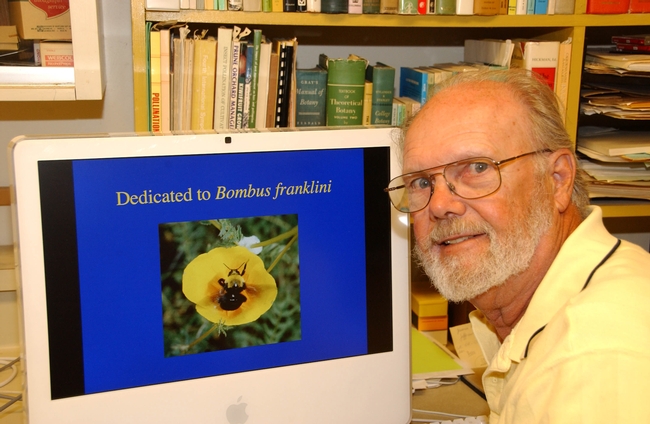
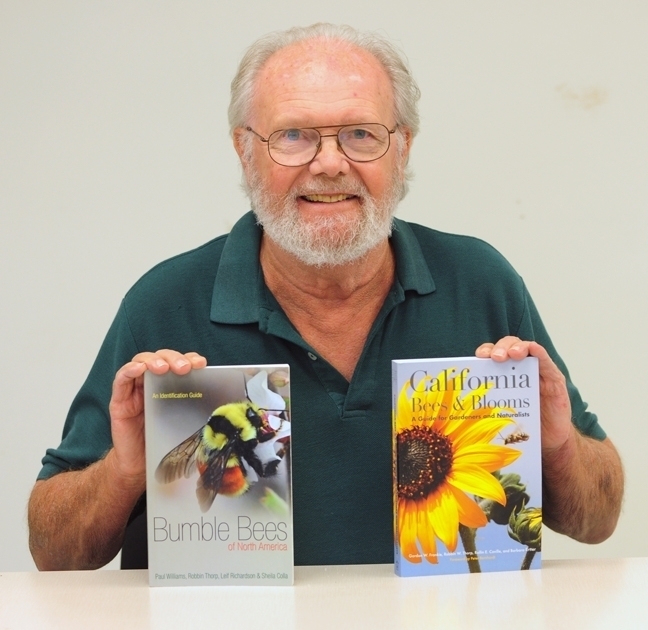
- Author: Kathy Keatley Garvey
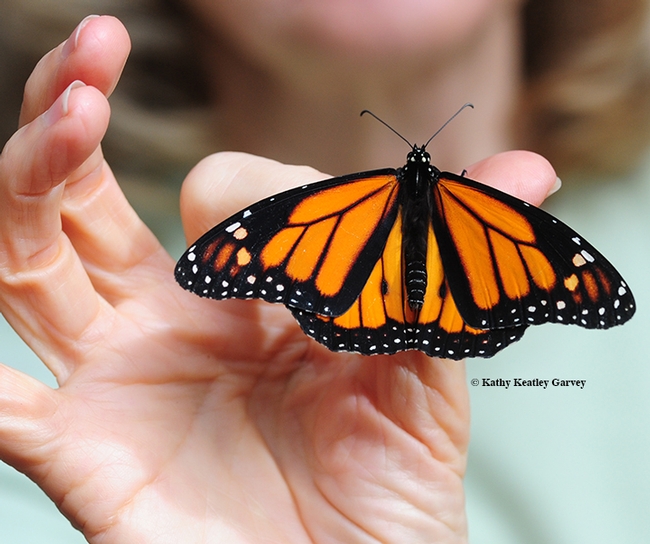
If you traveled to the Natural Bridges State Park in Santa Cruz this fall or to any of the other overwintering monarch sites along coastal California to see these iconic butterflies, did you see very many?
Probably not.
The Xerces Society of Invertebrate Conservation today announced "disturbingly low numbers" of monarch butterflies sightings.
"The Western Monarch Thanksgiving Count (WMTC) has been done annually for the last two decades," wrote Matthew Shepherd, director of communications and outreach. "We're still completing the count for this year, but preliminary results show disturbingly low numbers of monarch butterflies overwintering in California."
"The count results that we have from 97 sites show only 20,456 monarchs. In case you're thinking--'Wait, why say anything now before you have all the data?'--it's worth noting that the sites already reported include many of the most important overwintering groves and combined host the majority of monarchs overwintering in California. In 2017, these sites hosted approximately 148,000 butterflies, more than three quarters of the total monarch overwintering population. The 2018 numbers represents an 86% decline from last year—which was already a low population year."
"We were not expecting this to be a great year because we knew it had been a rough season in the breeding and migratory range, but it's looking worse than anyone had expected," Shepherd related. "If the rest of the Thanksgiving Count data show the same trend as these sites, we anticipate seeing less than 30,000 butterflies overwintering in California this winter. In comparison, last year there were more than 192,000 butterflies counted; in 1997, it was estimated that more than 1 million overwintered; and research suggest that there were at least 4.5 million monarchs overwintering in California in the 1980s."
To read more about the count and what may be causing this abrupt decline in numbers, access the Xerces blog, Early Thanksgiving Counts Show a Critically Low Monarch Population in California.
The Facebook page, Monarch Butterflies in the Pacific Northwest, affiliated with the migratory monarch research projects of Washington State University entomologist David James, knows the situation well.
On Nov. 27, the administrators posted: "This time last year we had found almost 50 of our PNW-tagged Monarchs in California! This year is a very different story with just 10 tag recoveries so far in California. The tenth recovery occurred on November 19 at the Moran Lake overwintering site in Santa Cruz. E5363 was spotted and photographed by John Dayton. This male was reared by Belinda Vos and released in Talent, Oregon on August 17 into extremely smoky skies. Regardless, E5363 flew 367 miles across the landscape to get to Santa Cruz."
And on Nov. 19, the PNW administrators posted:
"Good survival of our small overwintering populations is even more important this year, if we are to see a rebound in numbers next breeding season. However, we may get a boost from the eastern US population which unlike the west had an excellent breeding season in 2018. Back in 1994, the western Monarch population crashed to 'nothingness' then bounced back the next year. The late and revered Monarch researcher, Lincoln Brower connected this remarkable recovery with a likely westward shift of spring migrating Monarchs from the Mexican overwintering sites. He theorized that the western population may be subject to periodic declines from drought and climate cycles and depends on refreshment from Mexico. We will get the opportunity to see if this occurs in spring 2019. If the large summer population of monarchs in the eastern US translates into a large overwintering population, any 'leakage' to west of the Rockies could be significant. Let's keep our fingers crossed!"
And the U.S. Fish and Wildlife Service posted this on its Facebook page yesterday: "The California overwintering monarch population has been reduced to less than 0.5% of its historical size and has declined by 86% compared to 2017."
Want to help them? Here are a few things you can do, according to the U.S. Fish and Wildlife Service:
- Observe and report monarch sightings: https://www.monarchmilkweedmapper.org/
- Plant nectar resources and native plants
- Reduce pesticide use
Meanwhile, brace yourself for a dreary monarch season next year.
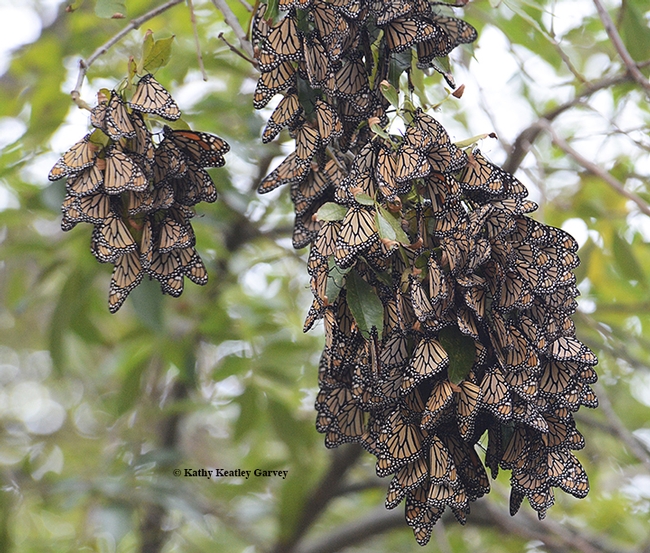
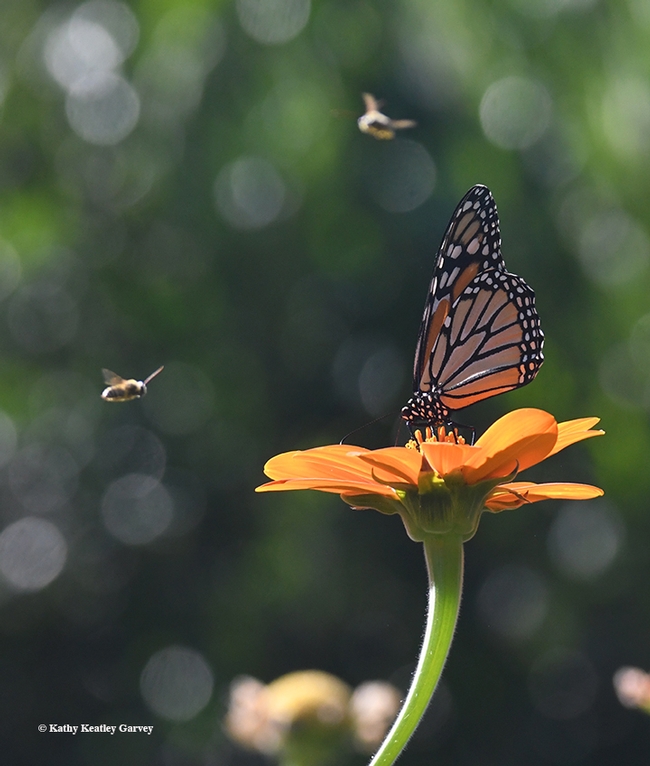
- Author: Kathy Keatley Garvey
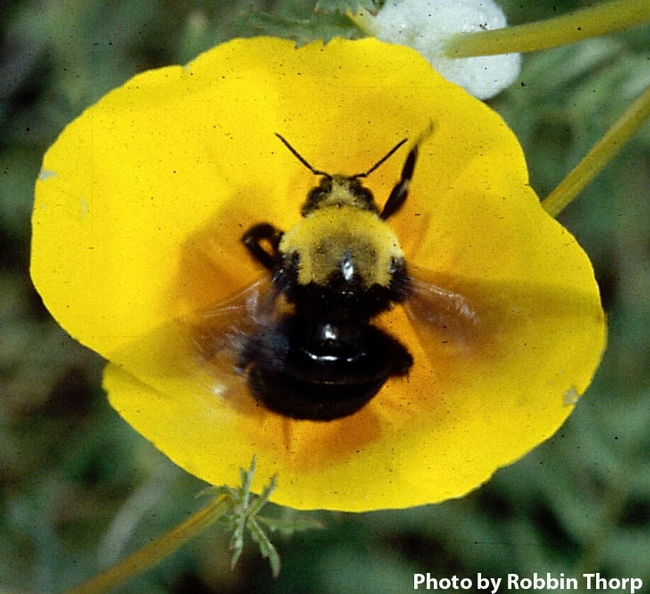
The question is: Where are you? Have you managed to "hide" all these years or are you extinct?
A “search party” of scientists and citizen scientists is forming to look for Franklin's bumble bee and other rare bumble bees from Monday, July 17 through Friday, July 21 at Mt. Ashland, Ore.
Noted bumble bee expert Robbin Thorp, distinguished emeritus professor of entomology at UC Davis, will be there to identify the bees. In addition, he will present a brief introductory training session, showing examples of bumble bees that inhabit the area, “and especially the rare ones we hope to find.”
The event, organized by Jeffrey Dillon, Endangered Species Division Manager, U.S. Fish and Wildlife Service, Portland, Ore., mainly involves searching for Bombus franklini and the endangered Western bumble bee, Bombus occidentalis, in the Mt. Ashland and Siskiyou-Cascade National Monument area. The survey is open to all interested volunteers.
Both bumble bees are on the Red List of Threatened Species of the International Union for Conservation of Nature and Natural Resources (IUCN).
“The objective is to get more eyes out looking for the rare bumble bees,” said Thorp, co-author of Bumble Bees of North America, An Identification Guide.
Thorp will provide a "Bumble Bee 101 Tailgate Course" at 3 p.m. on Monday, July 17. The group will meet him "a few hundred yards west of the Mt. Ashland ski resort (just before reaching the gravel road)," Dillon said. Thorp also will be there Tuesday morning for an informal overview of bumble bees.
Thorp, who has been monitoring Franklin's bumble bee since 1998, hasn't seen the bee since Aug. 9, 2006, when he spotted it in a meadow near Mt. Ashland. In August of 2016 a documentary crew from CNN, headed by John Sutter, followed Thorp to the same meadow. Sutter wrote about Thorp, then 82, in a piece he called "The Old Man and the Bee," a spinoff of Ernest Hemingway's "The Old Man and the Sea."
"That black-and-yellow bee, which looks like so many others except for the characteristic 'U' on is back, is the object of Thorp's obsession," wrote Sutter. "It's a creature he told me flies through his dreams always just out of reach."
Thorp says the distinctively marked bumble bee has the most restricted range of any bumble bee in the world. Its habitat is--or was--a small area of southern Oregon (Douglas, Jackson and Josephine counties) and northern California (Siskiyou and Trinity counties).
Franklin's bumble bee frequents California poppies, lupines, vetch, wild roses, blackberries, clover, sweet peas, horsemint and mountain penny royal during its flight season, from mid-May through September, Thorp points out. It collects pollen primarily from lupines and poppies and gathers nectar mainly from mints.
Thorp sighted 94 in 1998; 20 in 1999; 9 in 2000 and only 1 in 2001. Sightings increased slightly to 20 in 2002, but dropped to 3 in 2003. Thorp saw none in 2004 and 2005; one in 2006; and none since.
In a UC Davis interview in July 2010, Thorp said: “People often ask the value of Franklin's bumble bee. In terms of a direct contribution to the grand scale of human economies, perhaps not much, but no one has measured its contribution in those terms. However, in the grand scheme of our planet and its environmental values, I would say it is priceless.”
“Loss of a species, especially a pollinator, diminishes our global environment,” he said. “Bumble bees provide an important ecological service--pollination. This service is critical to reproduction of a huge diversity of plants that in turn provide shelter, food (seeds, fruits) to diverse wildlife. The potential cascade of effects from the removal of even one localized pollinator may affect us directly and indirectly.”
Meanwhile, Thorp keeps looking.
Dillon emailed survey volunteers that “we plan to spend two full days, Tuesday and Wednesday up on Mt. Ashland, a day over at the Hobart Bluff area (Thursday), and potentially part of a day at Grizzly Peak (Friday morning). Volunteers are welcome for part of the survey or all of it."
Some of the habitat is rugged terrain. All volunteers are encouraged to bring their own nets, and any medication needed if they are allergic to bee stings. Inexperienced folks will be paired with the more experienced, Dillon said.
"If you don't make it over on Monday, we will be up on Mt. Ashland to start the day between 8:30 and 9 a.m. Tuesday and Wednesday. "To find us, go to the Mt. Ashland ski resort. Then continue west past the resort onto the gravel road. Stay basically at the same elevation for about 1 to 1.5 miles past the ski resort--there are other side roads that go down or up oin elevation. You should run into a cluster of vehicles on the side of the road with a number of people nearby that appear to be wandering aimlessly through the alpine meadows with white nets. There will not have been an escape, just fellow bumble bee enthusiasts hoping to be the first to find a Franklin's bumble bee."
“We have already reserved and covered the cost of the group campsite (there is only one) at the Emigrant Lake campground for the week. There are four level tent areas that hold several tents each with plenty of parking space. Showers and restrooms are a short walk away. Everyone is welcome to camp with us if interested.” The campground is located southeast of Ashland on the north edge of Emigrant Lake (reservoir). "Following the main road through the campground, the group site is basically the last campsite area before heading around the lake--it will be on your left. On Monday, July 17, we will probably get there between 5:30 and 6 p.m. We have already covered the cost of the campsite.
For further information, Dillon's office number is (503) 231-6197 and his email is jeffrey_dillon@fws.gov
Results of the 2016 U.S. Fish and Wildlife Service, Portland, Ore., survey:
- Bumble bee species found at Mt. Ashland on July 18/19, 2016:
Bombus mixtus, B. melanopygus, B. bifarius, B. vosnesenskii, B. flavifrons, B. occidentalis, B. appositus, and B. insularis. Had a report of a B. vandykei but did not see it. - Bumble bee species found at Hobart Bluff trailhead area July 20, 2016:
Bombus mixtus, B. vosnesenskii, B. flavifrons, B. appositus, B. californicus, B. griseocollis, B. flavidus, and B. insularis. - Bumble bee species found at Grizzly Peak area July 21, 2016:
B. vosnesenskii, B. flavifrons, and B. appositus.
